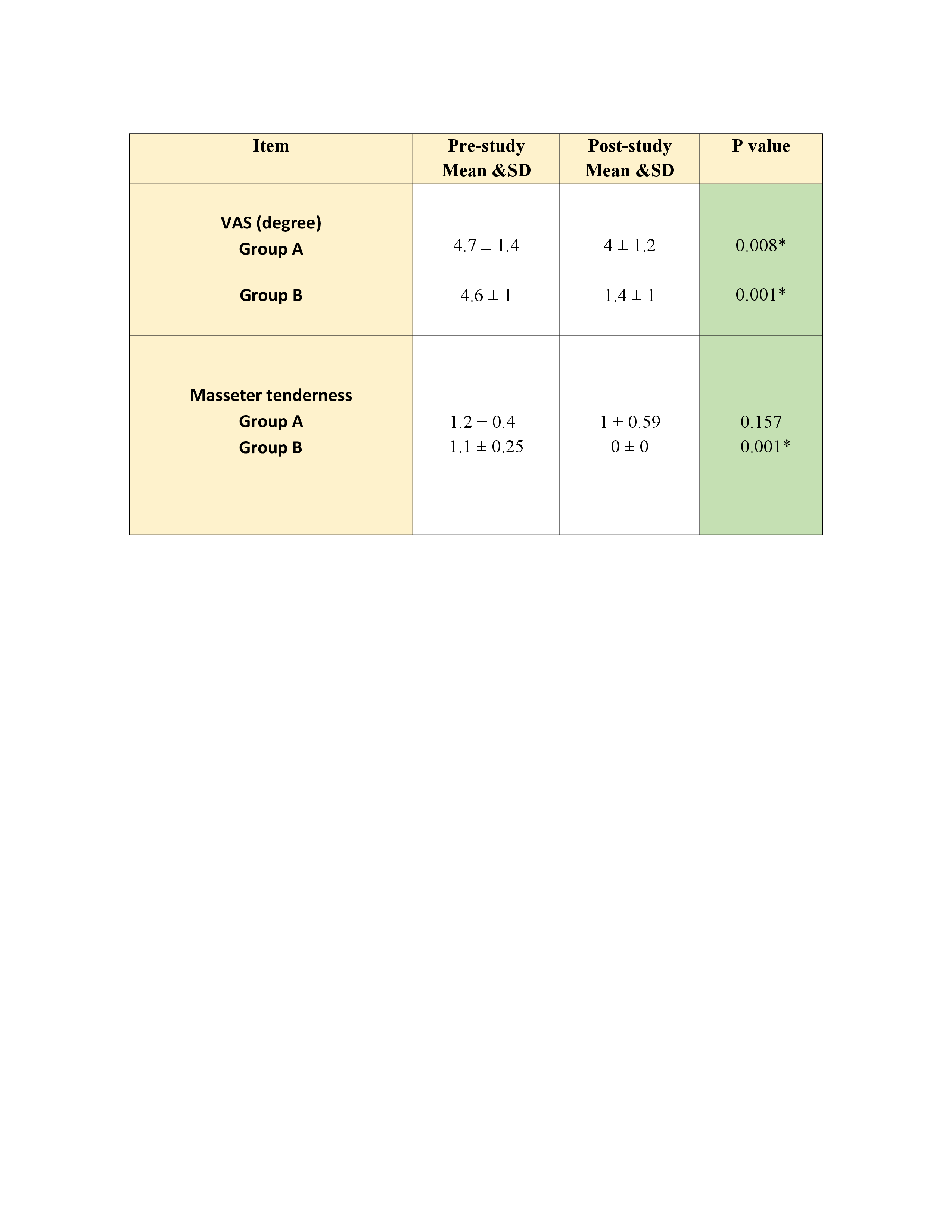Objective: To determine if masticatory muscles’ pain and tenderness in bruxers should be treated independently.
Background: Bruxism is a movement disorder with marked hyperactivity in the masticatory muscles leading to myofascial pain and tenderness [1]. Both the pain and tenderness in the dental field treated with the same standard medical treatments [2].
Method: Thirty bruxers patients with mild to moderate pain and masticatory muscles’ tenderness were recruited in this study. Patients were allocated randomly into two equal groups. Group (A): treated with the nonsteroidal anti-inflammatory drug for one month and group (B): treated with the nonsteroidal anti-inflammatory drug in addition to the electromyography biofeedback training for one month under the following 3 stages: threshold-based down training, dynamic training by eating different food with different consistency and the quick deactivation. The masseter has been chosen for this training program as it’s the initiator of the chewing process [3]. The pain was assessed by the visual analog scale and the tenderness was assessed by the digital palpating scale [4]. The alpha point of 0.05 was used as a level of statistical significance (when P ≤ 0.05 is usually classified as “significant”, P ≤ 0.01 as “Highly significant “, and P ≤ 0.001 as “Extremely significant “[5].
Results: In group (A): there was a highly significant difference in pain post-study in which P-value equal 0.008 while group (B): showed an extremely significant difference in pain post-study in which the P-value equal 0.001. on the other hand, group (A) don’t show a significant difference in masticatory muscles’ tenderness post-study in which the P-value equal 0.157 comparing to group (B) which showed an extremely significant difference in masticatory muscles’ tenderness as the P-value equals 0.001as shown in Table (1).
Conclusion: The significant difference in pain and tenderness improvement in bruxers confirmed that there’s a need for separate lines of treatment for each of the two problems. The standard medical treatment improves the pain, but the patients remain to complain from the tenderness and fatigue all over the masticatory muscles during rest or during the chewing process.
Electromyography biofeedback training sensory tricking the central pattern generator through a motor learning process that regulates the initiation, stopping, and rhythm of the movement.
References: 1-Reddy, S. V., Kumar, M. P., Sravanthi, D., Mohsin, A. H. B., & Anuhya, V. (2014). Bruxism: a literature review. Journal of international oral health: JIOH, 6(6), 105.
2- Cheng, Y., Yuan, L., Ma, L., Pang, F., Qu, X., & Zhang, A. (2021). Efficacy of botulinum-A for nocturnal bruxism pain and the occurrence of bruxism events: A meta-analysis and systematic review. British Journal of Oral and Maxillofacial Surgery.
3-Reich A, Heisig M, Phan NQ, Taneda K, Takamori K, Takeuchi S, et al.(2012). Visual analogue scale: evaluation of the instrument for the assessment of pruritus. Acta Derm Venereol 2012; 92: 497–501.
4- Okeson, J. P. (2014). Management of temporomandibular disorders and occlusion-E-book. Elsevier Health Sciences. Chapter 1, p.p.2-19.
5-Kirkwood, B. R., & Sterne, J. A. (2010). Essential medical statistics. John Wiley & Sons.P.P.102-117
To cite this abstract in AMA style:
M. Amine, U. El-Dakrory. Improvement of masticatory muscles’ pain versus tenderness via electromyography biofeedback training in patients with bruxism. [abstract]. Mov Disord. 2022; 37 (suppl 2). https://www.mdsabstracts.org/abstract/improvement-of-masticatory-muscles-pain-versus-tenderness-via-electromyography-biofeedback-training-in-patients-with-bruxism/. Accessed December 23, 2025.« Back to 2022 International Congress
MDS Abstracts - https://www.mdsabstracts.org/abstract/improvement-of-masticatory-muscles-pain-versus-tenderness-via-electromyography-biofeedback-training-in-patients-with-bruxism/

